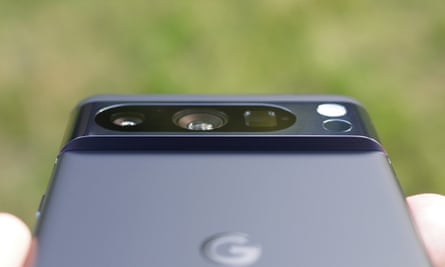Google’s flagship Pixel is returning with a seven-year full software support guarantee to outperform, outlast, and outshoot the competition. However, it is debatable if the high-end capabilities of the Pixel 8 Pro warrant a significant price hike.
The new Android still costs less than the $1,200 competition from Apple and Samsung at £999 (€1,099, $999, A$1,699), but the £150 price increase over the outstanding 7 Pro from a year ago stings.
The phone has a sophisticated glass and aluminum design. The fantastic 6.7-inch OLED panel is now flat, rather than having curving corners like it did on earlier Pixel Pro models. It scrolls incredibly smoothly and has an amazing peak brightness of 2,400 nits, but only for a short period of time in direct sunlight before fading to still-very-readable levels.

An improved 2D face-unlock technology that can now authenticate payments in addition to phone unlocks is new for this year. Although it is not as sophisticated as certain 3D facial recognition systems, like as Apple’s facial ID system, and it is not as effective in low light or when wearing sunglasses, it was sufficient in my tests when used in conjunction with the under-display fingerprint sensor.
On paper, Google’s new Tensor G3 chip trails top competitors from Qualcomm and Apple yet performs just as well in terms of games, apps, and everyday use. Similar to the Pixel 7 Pro, the battery life is about 37 hours between charges, which is sufficient for even a full day of use. However, you’ll probably need to charge it at night, which takes about 85 minutes using a 30W charger.
Specifications
- Screen: 6.7in 120Hz QHD+ OLED (489ppi)
- Processor: Google Tensor G3
- RAM: 12GB of RAM
- Storage: 128, 256 or 512GB
- Operating system: Android 14
- Camera: 50MP + 48MP ultrawide + 48MP 5x telephoto, 10.5MP selfie
- Connectivity: 5G, eSIM, wifi 7, UWB, NFC, Bluetooth 5.3 and GNSS
- Water resistance: IP68 (1.5m for 30 minutes)
- Dimensions: 162.6 x 76.5 x 8.8mm
- Weight: 213g
Android 14 with seven years of updates

Significantly longer software support is one of the Pixel’s most significant improvements this year. The 8 Pro will be secure to use until at least October 2030 because it comes pre-installed with the most recent version of Android (version 14) and a promise of seven years of security upgrades. That puts Google on level with the iPhone from Apple and outperforms other well-known Android manufacturers by at least two years. Only Fairphone provides more with a 10-year warranty.
It’s a huge deal since it extends the phone’s functional life and maybe its worth on the secondary or third-hand market, which will hopefully keep it in use longer and be better for the environment and your money. We can only hope that it will inspire other well-known brands to catch up.
Generative AI everywhere

Google has jumped on the much-hyped generative AI bandwagon, integrating it into a number of phone features and vowing to expand it to more in the future, including Assistant, using its Bard AI.
Several of the capabilities, like Assistant’s capacity to summarize webpages and articles, are now restricted to users in the US. Others include a cool wallpaper maker and the option to have articles read aloud to you. In addition, the assistant is considerably more adept at picking up on the rhythms of genuine speech and handling your ‘umms’ and ‘errs’ so you don’t have to rush questions. The punctuation for voice typing now inserts correctly when you pause, which is a major improvement.
Google Photos infused with more AI
Google Photos has also received more generative AI technology. The company has improved its “Magic Eraser” to the full “Magic Editor”. Using AI to regenerate portions of the image so that it all blends seamlessly, you may choose people and things and move, resize, replace the sky, or change the light on them. You can select the best of four possibilities at a time, or you can press the regenerate button to get more. Although this beta feature can take up to 30 seconds to activate, when it does, it can be quite wonderful.
Another new function for the Pixel is called “Best Take,” which combines the faces of several photographs to create a single “best” snapshot of a group of people, all of whom are dressed to the nines. It will work with the majority of existing group photos in Google Photos, not only those just taken with the 8 Pro. Best Take is the answer for everyone who has tried to take pictures of many kids who are all looking at the camera at once.
The new Audio Magic Eraser function can analyze your movies and separate sounds into individual channels, allowing you to selectively lower the loudness of certain noises, like traffic noise in a cityscape or an airplane overhead. Although it isn’t always flawless, it generally works without much user input.
More generative AI features, such as the ability to enlarge and improve existing photos using AI, as well as the first-ever low-light night vision mode for videos, will also be added in future updates, according to Google.
Camera

The 8 Pro continues Google’s tradition of having some of the greatest cameras available. Bigger, brighter sensors than the phone’s predecessors have been added to the base hardware, which enhances low-light images and lessens blur in scenes with rapid movement.
The telephoto camera with a 5x optical zoom and the main camera both take outstanding pictures, but the ultrawide camera is the most advanced. Similar to the Pixel 7 Pro from a year ago, the camera uses only the center pixels of the sensor to provide an additional 2x optical zoom on the main camera and 10x on the telephoto, which works quite well as long as the lighting is enough.
There are plenty of entertaining automatic functions to experiment with, but the 8 Pro also offers complete manual controls for the first time, letting you take 50MP photos in RAW format (or on digital negatives), as well as alter the shutter speed, ISO, and focus.
Overall, the 8 Pro is a superb point-and-shoot camera since it produces excellent photographs with the least amount of effort in trickier scenarios, like fast-moving people or low light.
Sustainability
Although the battery should withstand more than 500 full charge cycles with at least 80% of its original capacity, Google does not specify an expected lifespan for the battery. The phone can be fixed by Google and independent repair facilities, and iFixit will soon stock genuine replacement parts. Google charges £116 for out-of-warranty screen replacements and £56 for batteries.
At least 18% of the materials used to make the Pixel 8 Pro were previously used, including recycled plastic, tin, and aluminum. In its research, the business lays down the phone’s environmental impact. Google will recycle used electronics at no cost.
Price
The Google Pixel 8 Pro costs from £999 (€1,099/$999/A$1,699).
For comparison, the Pixel 8 costs £699, the Samsung Galaxy S23 Ultra costs £1,249, the Apple iPhone 15 Pro Max costs £1,199 and the Fairphone 5 costs £649.
Verdict
The Pixel 8 Pro might not be quite the high-end bargain of its predecessors, but it still offers more bang for your buck than rivals.
The screen, body, performance and battery life are all good. The Pixel has a distinctive look that elevates it from the many of the competition, too. It has a really great camera system, with an array of advanced AI-infused editing tools that blur the line between what’s real and what’s fake. Used in a responsible fashion, they can be super fun and useful.
The phone also ships with the promise of more Google generative AI tech to come in the near future, which is a general theme of Google’s hardware: good now, with the potential for constant improvements in feature updates.
But the biggest upgrade is in the full seven years of software support, bringing the Pixel up to par with Apple and outlasting all but the Fairphone 5 on the Android side. A very good step in the right direction for sustainability.
Pros: seven years of software updates, great camera with 5 and 10x optical zoom, great screen, decent battery life, recycled aluminium, impressive local and generative AI features, undercuts rivals on price.
Cons: bump in price, face unlock option not as secure as Face ID, battery life and raw performance short of best-in-class, temperature sensor is a gimmick for now.





